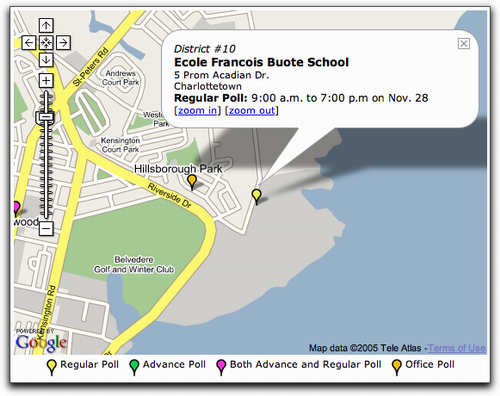Prince Edward Island is holding a Plebiscite on Mixed Member Proportional Representation System on November 28, 2005.
On Plebiscite Day voters can vote at any one of the polling stations in their electoral district. This is different from a Provincial General Election, where each elector falls into a polling division and must vote at a specific poll in their district.
To aid voters in locating the polling stations (along with the advance polls, for those that need to vote early) in their district, we’ve leveraged Google Maps to create an interactive Polling Station Locations Map.
The map uses various bits of the Google Maps API to show the polling locations for each district when its name is clicked on. Clicking on any polling location shows the address and the hours for voting at that location. All the regular Google Maps functionality — zoom, pan, etc. — is available as well.

I’m becoming more and more pleasantly surprised by the versatility of the Google Maps API — it’s possible, with a little bit of PHP and a little bit of JavaScript to create extremely powerful applications, application that, in an earlier day, would have been impossible to create or taken weeks of custom coding.
 I am
I am
Comments
Great! Now one question: What
Great! Now one question: What is the “Mixed Member Proportional System as presented by the Commission of PEI’s Electoral Future” and where can one find it online?
http://www.electoralfuture.pe
http://www.electoralfuture.pe….
The summary? It’s a bastardization of democracy. They take the 27 seats in the Provincial Government and elect 17 of them normally. Then they take the popular vote for each party, and based on the ratio of popular vote to actually elected candidates, 10 MLAs are elected *from a list of people that no one gets to vote on.* So basically the parties get to put their cronies, that could never get elected in a democratic way, in power.
Ah, but what does it matter
Ah, but what does it matter to the jaded youth of PEI (or Canada) in the 18-35? age bracket who aren’t voting…
Why not suggest primary elections for party candidates, if unaccountability for the “chosen 10” is such a problem?
Or, why have parties at all? After all, we are terribly over-represented in this province. Urban centres such as Oakville, Burlington, Cambridge (Ont.), Richmond (B.C.), or St. John’s (N.L.) are all around the 100-200k population mark and are governed with usually about a dozen elected municipal officials, plus anywhere from 1-2 or even 3 provincial MLAs/MPPs and 1-2 MPs.
We exist with 27 MLAs, many of whom in PEI appear to be in politics “just because it is a decent job” (and it is, compared to what our economy can offer - elected office is an industry unto itself these days); and our quality of elected officials is completely at the bottom of the national barrel as a result. Then there are the municipalities and all of their elected councillors, many of whom wouldn’t get a job as a janitor in any other jurisdiction. Then there are the 4 MPs, all of whom are a complete joke on the national stage…
What do we get for over-representation? Back-scratching, pocket-stuffing party politicking that doesn’t serve the people… unprogressive economic, social and environmental policies. Then we get a premier who goes about like a dictator wanting “super majorities” whenever somebody with more education than him (Carruthers) challenges his Liberal/Tory old boys flock with something that could really shake up the system…
Why not make PEI a true guinea pig for the nation by removing party politics completely, elect 10-12 MLAs or “representatives” at large, then, following the example of the territories (or the Vatican), have them select the premier from amongst themselves. Have voter recall, have e-democracy with voter-responses to various initiatives brought about on a regular basis. Get rid of the secrecy of cabinet/executive council and let the people make the decisions.
I don’t like MMP, but I absolutely loath the status quo on our little sandbar (going back to stick my head in the sand)…
Add new comment